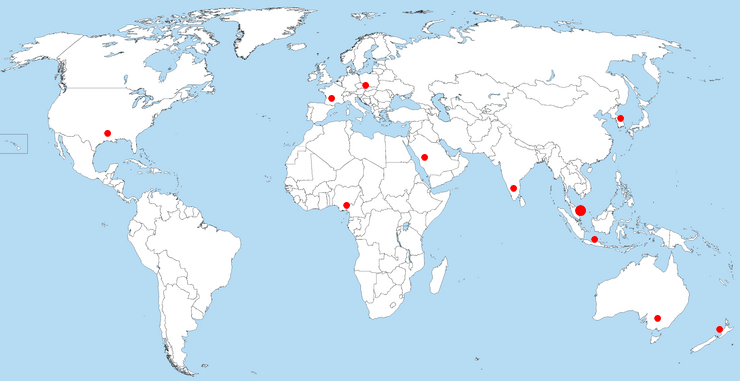MECHANISM OF MEMBRANE FOULING IN HYBRID MEMBRANE PHOTOCATALYTIC REACTOR FOR PALM OIL MILL SECONDARY EFFLUENT TREATMENT
DOI:
https://doi.org/10.11113/jm.v46.481Keywords:
Membrane fouling, Palm oil mill secondary effluent, Membrane photocatalytic reactorAbstract
Palm oil mill secondary effluent (POMSE) is a byproduct of the biological treatment of palm oil mill effluent. This research aims to investigate the mechanism of membrane fouling in the treatment of POMSE using a hybrid membrane photocatalytic reactor (MPR). The effectiveness of MPR in POMSE treatment is currently limited due to membrane fouling on the membrane surface. This study focuses on understanding the various mechanisms of membrane fouling, including complete blocking, intermediate blocking, standard blocking, and cake filtration. The determination of each fouling mechanism is achieved through an analysis of normalized flux data employing the Wiesner and Aptel equation. The results demonstrate a high degree of model fitness (R2 = 0.9576) for MPR Run 3, confirming its effectiveness. Based on the (R2) values and the fitted parameter (Ks^(-1)), it is evident that, under varying pH levels, catalyst types, catalyst loading, and initial POMSE concentrations, the cake formation fouling mechanism prevails in MPR Run. In conclusion, this research holds promising potential for implementation in the wastewater treatment industry while ensuring compliance with environmental regulations.
References
EPOA. (2019). The Palm Oil story. European Palm Oil Alliance (EPOA), 1–16. https://palmoilalliance.eu/wp-content/uploads/2019/10/Brochure-Palm-Oil-Story-2019-FINAL.pdf
Ratna, W., and Yan, R., Sustainability strategy of Indonesian and Malaysian palm oil industry: a qualitative analysis. Sustainability Accounting, Management and Policy Journal, 2021, 12: p. 1077-1107.
Abdul Majid, N., et al., Sustainable Palm Oil Certification Scheme Frameworks and Impacts: A Systematic Literature Review. Sustainability, 2021, 13: p. 3263.
Prantika, D., and Haripriya, Gundimeda., Is Biofuel Expansion in Developing Countries Reasonable? A Review of Empirical Evidence of Food and Land Use Impacts, Journal of Cleaner Production, 2022, 372: p. 133501.
Ramadhani, T.N., and Santoso, R.P., Competitiveness analyses of Indonesian and Malaysian palm oil exports, Economic Journal of Emerging Markets, 2019, 11: p. 46–58.
Voora, V., Larrea, C., Bermudez, S., & Baliño, S. (2019). Global Market Report : Palm Oil. International Institute for Sustainable Development., 16.
Nagpal, T., et al., Trans Fatty Acids in Food: A Review on Dietary Intake, Health Impact, Regulations and Alternatives. Journal of Food Science, 2021, 86: p. 5159–5174.
Hewlings, S., Coconuts and Health: Different Chain Lengths of Saturated Fats Require Different Consideration. Journal of Cardiovascular Development and Disease, 2020, 7: p. 59.
Purnama, K., et al., Processing, Characteristics, and Potential Application of Red Palm Oil - A review. International Journal of Oil Palm, 2020, 3: p. 40–55.
Monde Aké A., et al., Biochemical properties, nutritional values, health benefits and sustainability of palm oil. Biochimie, 2020, 178.
Almahdi, S., & Omar, S. (2019). Proposal for Palm Oil Mill Effluent (POME) Treatment at Source to reclaim water. American Based Research Journal, 8(5), 2304–7151. http://www.abrj.org
Nur Aleya L., et al., A brief review on biochemical oxygen demand (BOD) treatment methods for palm oil mill effluents (POME). Environmental Technology & Innovation, 2021, 21: p. 101258.
Dzinun, H., et al., Eggshell/TiO2 Composite for Palm Oil Mill Secondary Effluent Treatment. Multidisciplinary Applied Research and Innovation, 2021, 2: p. 253–259.
Safa Senan M., et al., Water reclamation from palm oil mill effluent (POME): Recent technologies, by-product recovery, and challenges, Journal of Water Process Engineering, 2023, 52: p. 103488.
Lya A., et al., Processing of Palm Mill Oil Effluent Using Photocatalytic: A Literature Review, Journal of Ecological Engineering, 2021, 22: p. 43–52.
Du, X., Shi, Y., Jegatheesan, V., & Ul Haq, I. (2020). A review on the mechanism, impacts and control methods of membrane fouling in MBR system. In Membranes (Vol. 10, Issue 2). https://doi.org/10.3390/membranes10020024
Ariffin Mohamad A., et al., Improved bubbling for membrane fouling control in filtration of palm oil mill effluent anaerobic digester sludge, Journal of Water Process Engineering, 2020, 36: p 101350.
Ayub, Md, Som., and Asdarina, Yahya., Kinetics and performance study of ultrasonic-assisted membrane anaerobic system using Monod Model for Palm Oil Mill Effluent (POME) treatment, Cleaner Engineering and Technology, 2021, 2: p. 100075.
Nazanin N., et al., Photocatalytic-membrane technology: a critical review for membrane fouling mitigation, Journal of Industrial and Engineering Chemistry, 2021, 93: p. 101-116.
Szabo-Corbacho, M.A., et al., Influence of the Sludge Retention Time on Membrane Fouling in an Anaerobic Membrane Bioreactor (AnMBR) Treating Lipid-Rich Dairy Wastewater. Membranes, 2022, 12: p. 262.
Sidik, D. A. B., Hairom, N. H. H., & Mohammad, A. W. (2019b). Performance and fouling assessment of different membrane types in a hybrid photocatalytic membrane reactor (PMR) for palm oil mill secondary effluent (POMSE) treatment. Process Safety and Environmental Protection, 130, 265–274. https://doi.org/10.1016/J.PSEP.2019.08.018
Amira Liyana D., et al., A comparative study of ZnO-PVP and ZnO-PEG nanoparticles activity in membrane photocatalytic reactor (MPR) for industrial dye wastewater treatment under different membranes, Journal of Environmental Chemical Engineering, 2019, 7: p. 103143.
Dilaeleyana A.B.S., et al., The potential control strategies of membrane fouling and performance in membrane photocatalytic reactor (MPR) for treating palm oil mill secondary effluent (POMSE), Chemical Engineering Research and Design, 2020, 162: p. 12-27.
Amira Liyana D., et al., Industrial textile wastewater treatment via membrane photocatalytic reactor (MPR) in the presence of ZnO-PEG nanoparticles and tight ultrafiltration, Journal of Water Process Engineering, 2019, 31: p. 100872.
Molinari, R., & Mozia, S. (2020). Editorial catalysts: Special issue on photocatalytic membrane reactors. Catalysts, 10(9), 1–4. https://doi.org/10.3390/catal10090962
Ezugbe, E. O., & Rathilal, S. (2020). Membrane technologies in wastewater treatment: A review. Membranes, 10(5). https://doi.org/10.3390/membranes10050089
Wiesner, M. R., & Aptel, P. (1996). Mass transport and permeate flux and fouling in pressure-driven processes. Water treatment membrane processes, 4-1.
Downloads
Published
How to Cite
Issue
Section
License
Copyright of articles that appear in Jurnal Mekanikal belongs exclusively to Penerbit Universiti Teknologi Malaysia (Penerbit UTM Press). This copyright covers the rights to reproduce the article, including reprints, electronic reproductions or any other reproductions of similar nature.








